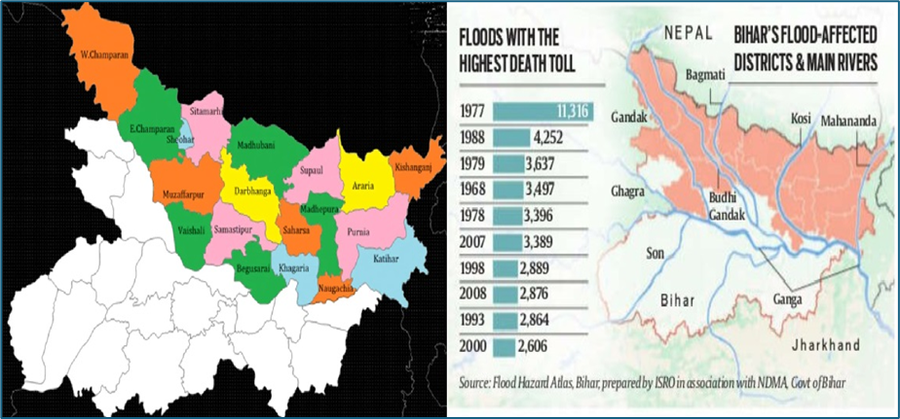Why in news?
Bihar is once again facing severe floods, affecting 11.84 lakh people who have been displaced, relying on air-dropped food packets and shelters, and at risk of water-borne diseases.
North Bihar experiences annual flooding, with lakhs of people seeing their crops and livestock destroyed each time. Despite efforts to rebuild, the cycle of devastation repeats every year.
What’s in today’s article?
- Bihar’s vulnerability
- Why is Bihar prone to annual flooding?
- Economic impact of Bihar’s floods
- Potential Solution
Bihar’s vulnerability

- Vulnerability
- Bihar is India’s most flood-prone state, with 76 per cent of the population in north Bihar living under the recurring threat of flood devastation.
- Bihar is crisscrossed by both snow-fed and rain-fed rivers, putting it at the risk of various kinds of floods.
- Four distinct types of floods
- Flash floods – It occurs due to rainfall in Nepal, lead time [time between forecast and flood] is short (8 hours), receding of flood waters is fast.
- River floods – It is typically caused by overflowing rivers. In this, the lead time is 24 hours and receding of flood waters takes one week or more.
- Drainage congestion floods: Occur in river confluences, taking more than 24 hours to develop and often lasting the entire monsoon season (about three months for water to recede).
- Permanent waterlogging: Affected areas remain waterlogged throughout the year.
Why is Bihar prone to annual flooding?
- Reason for first three kinds of floods
- A major reason for the first three kinds of flooding is that Bihar is located below Nepal, with its Himalayan rivers flowing down to the state.
- Because the Himalayas are a young mountain range with a lot of loose soil, these rivers — Kosi, Gandak, Burhi Gandak, Bagmati, Kamla Balan, Mahananda, Adhwara — are full of sediments.
- Thus, when the volume of water increases due to rains, the rivers quickly overflow their banks.
- Reasons behind the fourth category of permanent waterlogging
- The reasons of water-logging are spilling of silted small rivers, encroachment of drainage channels, embankment-induced waterlogging, and presence of saucer type depression locally called Chaurs.
- Chaurs are created due to a river changing course and deposition of its sediments.
- Kosi challenge
- Bihar’s geography makes annual floods inevitable, with the Kosi River, known as the "sorrow of Bihar," being one of the most destructive.
- In the 1950s, embankments were constructed along the Kosi to control its flow, initially seen as a permanent solution.
- However, these embankments have frequently been breached and have introduced a new issue.
- By narrowing the river's course, the embankments have trapped sediments, causing the riverbed to rise by about 5 inches annually.
- This rising riverbed has made the Kosi more prone to overflowing, worsening the flood situation in the region.
- Flood in 2024
- This year, the flood has been caused by heavy rainfall and flooding in Nepal and release of water from its barrage on the Kosi river.
- This year’s flooding in Bihar is worse due to the release of 6.6 lakh cusec of water from the Birpur barrage on the Kosi River in Nepal, the highest discharge in nearly six decades.
- In India, embankments breached in seven locations across four districts, despite being designed to handle 9.5 lakh cusec.
- The breaches are occurring because the river has become shallower.
- Around 380 villages, home to 15 lakh people, are trapped within the embankments, with no escape from the recurring floods.
Economic impact of Bihar’s floods
- While the floods in Bihar don’t always result in significant loss of life, the economic toll is substantial.
- Damage to crops, livestock, and infrastructure is considerable, and the resulting distress migration exacerbates the state’s economic challenges.
- The government spends around Rs 1,000 crore annually on flood relief and management.
Possible solutions
- For decades, building a dam on the Kosi River has been proposed as a flood solution, but it requires cooperation from Nepal, delaying progress.
- Recently, Bihar govt requested the construction of an additional barrage on the Kosi and barrages on other rivers like the Gandak and Bagmati.
- However, the frequent breaches of embankments suggest that engineering solutions alone may not suffice.
- Experts have emphasized the need for both structural and non-structural solutions.
- Non-structural approaches include laws, risk reduction, early warnings, and flood preparedness.
- The Flood Atlas of Bihar also advocates focusing on minimizing risk and damage rather than relying solely on structural measures along dynamic rivers like the Kosi.










